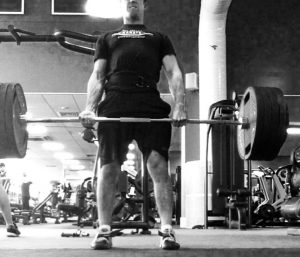- 4th July 2017
- By Matthew Fever

The barbell has been used for decades and has been proven by the strongest people on earth to be one of the best ways to build strength. So why are there so many resistance machines at the gym?
Head to any commercial gym or health club and you will no doubt find a vast amount of resistance machines that isolate each and every part of your body. These are normally the first exercises beginners are shown on their induction because they are perceived as safer, however there are some limitations to using this type of equipment.
Next time you are at the gym, take a look at these machines and you will notice a few things.
- Almost every single exercise requires you to sit down. You head to the gym to move more and engage in physical activity and then perform a series of movements where you are sat down. During my sessions, I want you to stand up, balance on your own two feet and move around.
- Many machines also have a limited number of adjustments, meaning that it is almost impossible to get different people of different sizes in the correct position.
- All of the exercises are supported and guide you through a predetermined range of motion. This is very different to barbell training where the load can move in all directions.
- General use of these machines requires you to perform one exercise for your arms, another for your shoulders, one for your legs etc perform them all and collectively you work the whole body. This is very different to how the body works in real life. In everyday activities and sports the body is required to operate as a co-ordinated, connected system of levers using the whole body as a unit, not by isolating one muscle at a time. Since we do not use the body in this way it makes sense not to train it in this way. For most of these exercises the only time you will ever find yourself in these positions is when you are at the gym sat on these machines. There is very little carry over to every day life, since in every day movements we are required to produce force whilst standing on our feet.
- Many begin with resistance machines because they feel it’s safer. This is partly true. I have spent many years in gyms and seen it all when it come to ‘technique’, however, overloading certain isolated muscle groups in a way in which they are not designed to work, can be problematic too.
The resistance machine became popular back in the seventies, the main reason for their popularity is it allows gyms to sell more memberships. It’s hard to sell a membership without fancy machines. It opens the doors to the masses and also means that experienced staff are not required to show people how to use this type of equipment. Barbell training on the other hand requires detailed experienced coaching.
Occasionally machines can be used to good effect. For example, a lat pull down or assisted chin up machine can be used whilst developing sufficient strength to perform the chin up. This is a great supplementary exercise to any barbell programme.
 So why use barbells?
So why use barbells?
Barbells are superior to machines for a number of reasons. The biggest benefit is that it allows more muscle mass to be trained over a great range of motion. This allows for more load to be lifted, more force to be produced and therefore drives a greater strength adaptation.
The barbell exercises are performed unsupported and standing (except the bench press), and the exercise is controlled by the result of your movement pattern – not that of the machine.
These exercises will improve not only strength but almost every other aspect of your fitness. Balance, co-ordination, power, flexibility, speed all of which improve with barbell training. Although least effected by gains in strength, the cardio respiratory system is still taxed through a demanding barbell session.
Barbell training is not just for young males looking to gain muscle, it is a valuable training method for females and older trainees that need to increase skeletal loading and improve bone density. Increasing lean body mass and improving the strength of your bones, joints and connective tissues will mean you have a stronger musculoskeletal system and reduce the risk of certain conditions such as osteoporosis.
What are the main barbell lifts?
Squat, press, deadlift, bench press, clean, snatch.
These are the main lifts that you will learn in my training sessions. These movements are referred to as compound movements, meaning they will train more than one muscle group and work over a series of joints. Squatting down, pressing overhead and picking things up off the floor are all things that you will do throughout your life. They are simply easier if you have trained your body to be stronger.
If you feel you could use a little coaching on these exercises, please get in touch.
